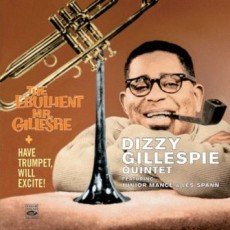
Daily Dose Of Jazz…
Dizzy Gillespie was born John Birks Gillespie on October 21, 1917 in Cheraw, South Carolina, the youngest of nine children of James and Lottie Gillespie. His father, a local bandleader, made instruments available to the children. He started playing the piano at the age of four and taught himself how to play the trombone as well as the trumpet by the age of twelve. From the night he heard his idol, Roy Eldridge, play on the radio, he dreamed of becoming a jazz musician. Receiving a music scholarship to the Laurinburg Institute in North Carolina, he attended for two years before accompanying his family when they moved to Philadelphia.
Gillespie’s first professional job was with the Frank Fairfax Orchestra in 1935, after which he joined the respective orchestras of Edgar Hayes and Teddy Hill, essentially replacing Roy Eldridge as first trumpet in 1937 and making his first recording as part of the band on King Porter Stomp. He would move on to play with Cab Calloway, alongside Cozy Cole, Milt Hinton and Jonah Jones until an altercation with Calloway got him fired. During his period he started writing big band music for bandleaders like Woody Herman and Jimmy Dorsey while freelancing with a few bands – most notably Ella Fitzgerald’s orchestra, comprised of members of the late Chick Webb’s band, in 1942. Avoiding service in World War II, he joined the Earl Hines band followed by a stint with Billy Eckstine’s big band, got reunited with Charlie Parker and finally left to play with a small combo of quintet size.
A forerunner of the evolution of bebop along with Parker, Monk, Bud Powell, Kenny Clarke, and Oscar Pettiford, Dizzy helped shape a new vocabulary of musical phrases. They jammed at Minton’s Playhouse and Monroe’s Uptown House with compositions like Groovin’ High, Woody ‘n’ You, Salt Peanuts and A Night In Tunisia that also introduced Afro-Cuban rhythms.
As an educator Gillespie taught or influenced many of the young musicians on 52nd Street including Miles Davis, Max Roach, Fats Navarro, Clifford Brown, Lee Morgan, Chuck Mangione and even balladeer Johnny Hartman about the new style of jazz, but after ambivalent or hostile reception in Billy Berg’s Los Angeles club, he decided to lead his own big band, though unsuccessful at his first attempt in 1945. He went on to work with Milt Jackson, John Coltrane, Lalo Schifrin, Ray Brown, Kenny Clarke, James Moody, J.J. Johnson and Yusef Lateef, whole appearing as a soloist for Norman Granz’s Jazz at the Philharmonic.
In 1948 Dizzy lost his ability to hit the B-flat above high C due to an automobile hitting the bicycle he was riding. He won the case, but the jury awarded him only $1000, in view of his high earnings up to that point. Not to be sidelined, he went on tour for the State Department earning himself the title Ambassador of Jazz. His new big band would tour the U.S. and record a live album at the 1957 Newport Jazz Festival and featured pianist Mary Lou Williams.
Dizzy immersed himself in the Afro-Cuban movement and hired Chano Pozo and Mario Bauza to play in his bands on 52nd Street, the Palladium and the Apollo Theater. He co-wrote with Pozo the songs Manteca and Tin Tin Deo, commissioned George Russell’s Cubano Be, Cubano Bop, and discovered Arturo Sandoval while on a music researching trip to Cuba.
As his tone gradually faded in the last years in life his performances often focused more on his protégés, such as, Arturo Sandoval and Jon Faddis, all the while keeping his good-humored comedic routines a part of his live act. Dizzy would go on to give 300 performances in 27 countries, appeared in 100 U.S. cities in 31 states and the District of Columbia, headline three television specials, performed with two symphonies, and recorded four albums.
Gillespie put himself on the ballot as a write-in candidate of the 1964 Presidential election, published his autobiography, To Be or Not To Bop, was a vocal fixture in many of the John & Faith Hubley’s animated films, such as The Hole, The Hat and Voyage to Next. He led the United Nation Orchestra, toured with Flora Purim and David Sanchez in his band, received Grammy nominations, guested on The Muppet Show, Sesame Street and The Cosby Show and had a cameo on Stevie Wonder’s hit Do I Do and Quincy Jones’ Back On The Block.
Inducted into the Down Beat Magazine’s Jazz Hall of Fame, Dizzy was also honored by being crowned a traditional chief in Nigeria, received the Ordre des Arts et des Lettres from France, and was named Regent Professor by the university of California, received fourteen honorary doctorates, received a Grammy Lifetime Achievement Award, the Polar Music Prize, a Hollywood Walk of Fame Star, the Kennedy Center Honors Award, and the Ameican Society of Composers, Authors and Publishers Duke Ellington Award for 50 years of achievement. Composer, performer, bandleader and trumpeter Dizzy Gillespie passed away of pancreatic cancer on January 6, 1993 in Englewood, New Jersey at the age of 75. In 2014, Gillespie was inducted into the New Jersey Hall of Fame.
More Posts: trumpet
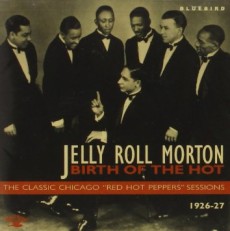
Daily Dose Of Jazz…
Jelly Roll Morton was born Ferdinand Joseph LaMothe on October 20, 1890 into a common-law creole of color family in the Faubourg Marigny neighborhood of downtown New Orleans, Louisiana. He started playing music as a child, showing early talent. After his parents separated, his mother married a man named Mouton and anglicizing it changed it to Morton.
At the age of fourteen, Morton began working as a piano player in a Storyville brothel, then known as a sporting house. In that atmosphere he often sang smutty lyrics and it was there he took the nickname “Jelly Roll”, which was African American slang for female genitalia. While working there, he was living with his religious, church-going great-grandmother; he had her convinced that he worked as a night watchman in a barrel factory. After Morton’s grandmother found out that he was playing jazz in a local brothel, she kicked him out of her house. However, Tony Jackson, also a pianist at brothels and an accomplished guitar player, was a major influence on his music.
Around 1904, Jelly Roll started touring in the American South, working with minstrel show, gambling and composing. He moved to Chicago in 1910 and New York City the following year where future stride greats James P. Johnson and Willie “The Lion” Smith caught his act, years before the blues were widely played in the North. His works Jelly Roll Blues, composed in 1915, has arguably become the first jazz song ever published. New Orleans Blues, Frog-I-More Rag, Animus Dance and King Porter Stomp followed as they were composed during this period. In 1917, he followed bandleader William Manuel Johnson Johnson’s sister Anita Gonzalez to California, where his tango The Crave, made a sensation in Hollywood. Returned to Chicago in 1923 to claim authorship of his recently published rag, “The Wolverines”, which had become a hit as “Wolverine Blues” in the Windy City. He released the first of his commercial recordings, first as piano rolls, then on record, both as a piano soloist and with various jazz bands.
In 1926, Morton succeeded in getting a contract to record for the largest and most prestigious company in the United States, Victor. This gave him a chance to bring a well-rehearsed band to play his arrangements. These recordings by Jelly Roll Morton & His Red Hot Peppers are regarded as classics of 1920s jazz. They featured Kid Ory, Omer Simeon, George Mitchell, Johnny St. Cyr, Barney Bigard, Johnny Dodds, Baby Dodds and Andrew Hilaire. And the group became one of the first acts to be booked on tour by MCA. Moving to New York City in 1928 he continued to compose and record for Victor with the aforementioned in addition to George Baquet, Albert Nicholas, Wilton Crawley, Russell Procope, Lorenzo Tio, Artie Shaw, Bubber Miley, Johnny Dunn, Henry “Red” Allen, Sidney Bechet,, Paul Barnes and Bud Freeman, Pops Foster, Paul Barbarin, Cozy Cole and Zutty Singleton.
During the Great Depression Morton lost his contract with Victor, struggled financially and took a job with a traveling burlesque show for steady income. In 1935, his 30-year-old composition King Porter Stomp arranged by Fletcher Henderson became Benny Goodman’s first hit and swing standard but Jelly Roll received no royalties from its recordings.
A move to Washington, DC saw him becoming the manager, piano player, master of ceremonies, bouncer and bartender of a bar located at 1211 U Street in the NW Black section of town called Shaw. Unable to make it a success due to the owner’s bad business decisions and being stabbed by a friend of the owner, Morton’s wife demanded they leave DC. Before his departure folklorist Alan Lomax invited him to record music and interviews at the Library of Congress, which ended after eight hours, though Lomax conducted longer interviews but only to notes without recording.
When Morton was stabbed and wounded, a nearby whites-only hospital refused to treat him, as the city had racially segregated facilities. Transported to a black hospital farther away it was several hours before being attended to and his recovery suffered, often he became short of breath. Worsening asthma sent him to a New York hospital for three months at one point and although he continued to suffer from respiratory problems when visiting Los Angeles, California with manuscripts of new tunes and arrangements, planning to form a new band and restart his career, pianist and composer Jelly Roll Morton passed away on July 10, 1941, after an eleven-day stay in Los Angeles County General Hospital. He was inducted into the Rock and Roll Hall of Fame, the Louisiana Hall of Fame and is a charter member of the Gennett Records Walk of Fame.
More Posts: piano
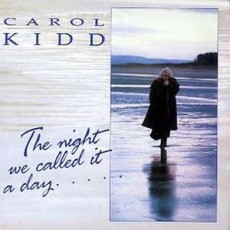
Daily Dose Of Jazz…
Carol Kidd was born on October 19, 1945 in Glasgow, Scotland and knew from five years old that she was a singer. She first came to prominence in the mid-Seventies as the vocalist for the band led by vibraphone and saxophonist Jimmy Feighan, and while raising three children and running a hotel she sang part-time all over Britain, performing on stage and television.
Kidd recorded her debut album Just For You in 1981 but it was three years before she released her self-titled sophomore project Carol Kidd and a third in 1985 titled All My Tomorrows. Her full-time professional career began in 1990 when Frank Sinatra issued her an invitation to appear live with him at Ibrox Stadium in Glasgow, in front of a capacity crowd. British jazz lovers gave rave reviews and Kidd was invited to sing at London’s internationally acclaimed Ronnie Scott’s Club, where Tony Bennett was in the audience. The momentum of her success picked up after that appearance and she was voted the Best Performer at Edinburgh International Jazz.
With four albums already under her belt, in 1990 Carol released her award-winning album, The Night We Called It a Day for Linn Records and was voted Best Jazz Recording at the U.K. Musical Retailer’s Awards. After being named Best Vocalist at the Cannes International Jazz Awards, she subsequently received invitations to appear all over Europe, the Far East and the United States.
For over a decade, jazz singer Carol Kidd has managed to consistently pull in accolades, “Best Awards,” and honors from an arena consisting of all-time greats such as Peggy Lee, Ella Fitzgerald, and Sarah Vaughan. She has won several awards at the British Jazz Awards and in 1998 she was awarded an MBE or Most Excellent Order of the British Empire for her services to jazz.
Jazz vocalist Carol Kidd has performed and recorded a standards album with the Robert Farnon Orchestra, has sixteen albums to date and continues to perform, record and tour all over the world.
More Posts: vocal
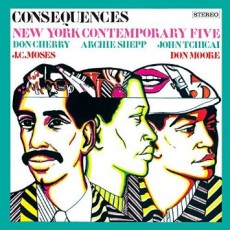
Daily Dose Of Jazz…
J. C. Moses was born in Pittsburgh, Pennsylvania on October 18, 1936 and was related to pianist Jimmy Golden and trumpeter Clifford Thornton. Somewhat of a mystery figure in jazz history, he was a very versatile and for a time greatly in-demand drummer who played in settings ranging from mainstream to free jazz.
Moses first gained the attention of the jazz world in the early 1960s, when he recorded with Clifford Jordan, Kenny Dorham and Eric Dolphy. As a member of the New York Contemporary Five with Archie Shepp, John Tchicai and Don Cherry, he toured Scandinavia in 1963 and recorded in Denmark. Returning to New York the following year, J. C. recorded with Bud Powell on the album The Return of Bud Powell, was with the New York Art Quartet, then was with an early version of Charles Lloyd’s Quartet and spent two years with Rahsaan Roland Kirk.
During this period drummer J. C. Moses also worked with Archie Shepp, Andrew Hill and Sam Rivers. By 1969 he played regularly in Copenhagen as the house drummer at the Montmartre Club. However, erratic health forced him to cut back on his activities in the early 1970s and he returned to Pittsburgh. Unfortunately he never led his own record date but he would occasionally played with Nathan Davis and Eric Kloss before his untimely death in 1977.
More Posts: drums
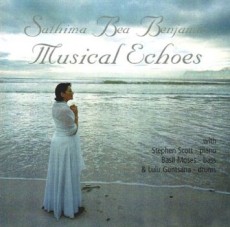
Daily Dose Of Jazz…
Sathima Bea Benjamin was born Beatrice Bertha Benjamin on October 17, 1936 in Claremont, Cape Town, South Africa. As an adolescent, she first performed popular music in talent contests at the local cinema (bioscope) during the intermission. By the 1950s she was singing at various nightclubs, community dances and social events, performing with notable Cape Town pianists Tony Schilder and Henry February, among others. She built her repertoire watching British and American movies and transcribing lyrics from songs heard on the radio. She discovered Nat King Cole, Billie Holiday, Doris Day and Ella Fitzgerald who greatly influenced her singing style, phrasing and diction.
At 21, she joined Arthur Klugman’s traveling show, Coloured Jazz and Variety, touring South Africa. When the production failed, she found herself stranded in Mozambique where she met South African saxophonist Kippie Moekets. Returning to Cape Town’s now thriving jazz scene in 1959, Sathima met pianist Dollar Brand, later known to the world as Abdullah Ibrahim. She would marry him in 1965 and the same year record with his trio what would have been the first jazz album in South Africa titled My Songs For You, but it was never released.
In the aftermath of South Africa’s 1960 Sharpeville Massacre, Benjamin and Ibrahim left South Africa for Europe, settling in Zurich. Along with bassist Johnny Gertze and drummer Makhaya Ntshoko they worked throughout Germany and Scandinavia, meeting and occasional working with American jazz players, such as, Don Byas, Dexter Gordon, Kenny Drew, Ben Webster, Bud Powell, John Coltrane and Thelonious Monk. The artist who would have the greatest impact on Benjamin’s life, however, was Duke Ellington.
Benjamin met Duke Ellington while he was in Zurich in 1963 asked that he hear her husband’s trio at the Club Africana. Obliging but insisting that she sing for him. Following this encounter, Ellington arranged for the couple to fly to Paris and record separate albums for Sinatra’s Reprise label. Her recording, A Morning in Paris, was thought lost and remained unreleased until 1966. Maintaining her musical relationship with Ellington she performed with his band in the U.S. at the Newport Jazz Festival. He subsequently asked her to join his band permanently but being newly wedded she declined.
Throughout the 1960s, Sathima moved back and forth between Europe and New York City as manager and agent for her husband while raising their son, Tsakwe. Returning to South Africa 1976 she gave birth to a daughter and recorded African Songbird, and then returned to New york City the following year. Launching her own record label, ekapa rpm, to produce, publish and distribute her and Ibrahim’s music, between 1979 and 2002, she released eight of her own albums on ekapa: Sathima Sings Ellington, Memories and Dreams, Windsong, Lovelight, Southern Touch, Cape Town Love, Musical Echoes and Dedications, the last receiving a Grammy nomination.
Benjamin collaborated on these albums with saxophonist Carlos Ward, pianists Stephen Scott, Kenny Baron,, Larry Willis and Onaje Allan Gumbs, bassist Buster Williams and drummers Billy Higgins and Ben Riley. She has been the recipient of South Africa’s Order of Ikhamanga Silver Award, was the feature of a 2010 documentary film Sathima’s Windsong, and has had a co-authorhip of her life Musical Echoes: South African Women Thinking In Jazz.
Sathima Bea Benjamin returned to Cape Town in 2011, where she continued to work as a vocalist until passing away on August 20, 2013, aged 76.
More Posts: vocal


